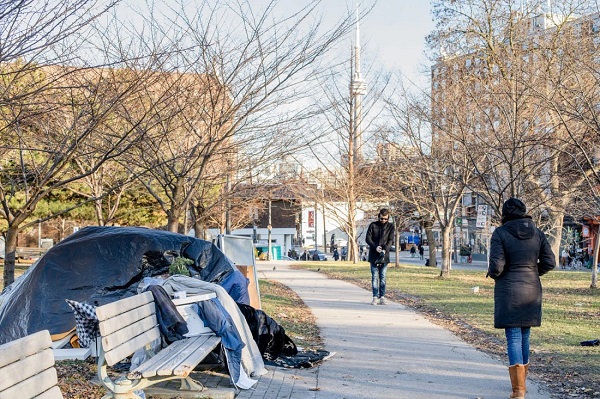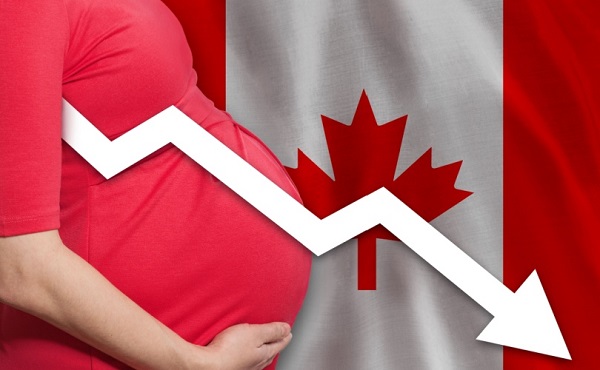Mental Health
Headline that reads ‘Ontario must pay for surgery to give trans resident both penis and vagina: appeal court’ a sign of the times in Canada

From LifeSiteNews
Gender ideology so entrenched, surgical mutilation is no longer considered fringe
If you’d like a glimpse of what 10 years of progressive rule has done to Canada in a single sentence, I submit to you this April 24 headline: “Ontario must pay for surgery to give trans resident both penis and vagina: appeal court.”
Imagine reading a headline like that in, say, 2010. You’d wonder what country you were living in — that is, if you weren’t trying to figure out what you just read. But in Canada in 2025, this stuff isn’t fringe. It’s establishment.
The Ontario Court of Appeal, the province’s top court, issued a ruling this week stating that the province must pay for a “penile-sparing vaginoplasty” for a resident who identifies as transgender but does not identify “exclusively” as either male or female and thus would like to possess both a penis and a vagina.
According to the Post, “a three-judge panel of the Ontario Court of Appeal confirmed a lower court’s ruling that the novel phallus-preserving surgery qualifies as an insured service under the Ontario Health Insurance Plan.” In case you’re tempted to write this off as an aberration at the hands of a handful of activist judges, this ruling is the third unanimous decision in favor of the “patient,” identified in court records as “K.S.”
“K.S. is pleased with the Court of Appeal’s decision, which is now the third unanimous ruling confirming that her gender affirming surgery is covered under Ontario’s Health Insurance Act and its regulation,” K.S.’s lawyer, John McIntyre, told the Post. K.S., as it turns out, identifies as neither male nor female … but uses female pronouns:
The legal battle between K.S., whose sex at birth was male, dates to 2022, when the Ontario Health Insurance Plan (OHIP) refused her request to pay for the cost of surgery at a Texas clinic to construct a vagina while sparing the penis, a procedure this is not available in Ontario, or anywhere else in Canada. K.S. uses female pronouns but does not identify as either fully female or fully male.
Previously, saner generations would have no idea how to interpret the preceding paragraph, but gender ideology has made fools of us all. OHIP attempted to argue that “because the vaginoplasty would not be accompanied by a penectomy, the procedure isn’t one specifically listed in OHIP’s Schedule of Benefits and therefore shouldn’t be publicly funded” and also that the surgery is “experimental” in Ontario and thus can’t be covered.
But K.S., who has a male member but would also like a neo-vagina, appealed to the Health Services Appeal and Review Board, which overturned OHIP’s decision. OHIP appealed to the Divisional Court but lost; the latest appeal, heard November 26, was also rejected because a “penectomy,” the removal of the penis, was “neither recommended by K.S.’s health professionals nor desired by K.S.,” according to the court’s decision.
I wonder if the judges thought that they’d be ruling on whether a man who identifies as neither a man or a woman was entitled to obtain a vagina while retaining his penis when they were going to law school.
The court stated that K.S., who is in his early 30s, “has experienced significant gender dysphoria since her teenage years, as well as physical, mental and economic hardships to transition her gender expression to align with her gender identity.” Of course, K.S. isn’t “transgender,” per se — because he doesn’t identify as the opposite sex, even though he uses the pronouns of the opposite sex. He wants to be … both, somehow. And he wants the taxpayer to pay for it.
As the Post reported:
K.S.’s doctor submitted a request to OHIP for prior funding approval for the surgical creation of a vaginal cavity and external vulva. The request made it clear that K.S. wasn’t seeking a penectomy. In a letter accompanying the request, her doctor said that because K.S. is “not completely on the ‘feminine’ end of the spectrum” it was important for her to have a vagina while maintaining her penis, adding that the Crane Center for Transgender Surgery in Austin, Tx.,” has an excellent reputation” for gender-affirming surgery, “and especially with these more complicated procedures.”
The surgeries, depending on which are performed, range in cost “from US $10,000 to $70,000.” The court also ordered Ontario to pay K.S. $23,250 after dismissing OHIP’s appeal; the province has until June 23 to seek leave to the Supreme Court of Canada.
Alberta
Alberta puts pressure on the federal government’s euthanasia regime

From LifeSiteNews
Premier Danielle Smith is following through on a promise to address growing concerns with Canada’s euthanasia regime.
Alberta Premier Danielle Smith has sent a mandate letter to Justice Minister Mickey Amery directing him to draft and introduce new legislation on euthanasia to ensure better oversight of so-called “medical aid in dying,” or “MAiD” and to prohibit it for those suffering solely from mental illness.
In December of last year, Smith’s United Conservative government indicated that they would seek to address growing concerns with Canada’s euthanasia regime. Mainstream media outlets attacked the move, with the CBC actually reporting that: “Some are concerned new limitations could impact already vulnerable Albertans.”
Premier Smith has now followed through on that promise. The September 25 mandate letter, which lays out directives on a wide range of issues, calls for the justice minister to take steps to protect vulnerable Albertans suffering from mental illness:
As lead, work with relevant ministries to introduce legislation to provide greater oversight and appropriate safeguards for medical assistance in dying and prohibit medical assistance in dying where a person seeks this procedure based solely on a mental illness.
In an email to the CBC, Amery stated that while euthanasia law is under federal jurisdiction, healthcare falls under provincial jurisdiction. The CBC falsely claimed that mental illness “has never been an approved sole eligibility factor for MAID, though the government has considered permitting it.” In fact, the Trudeau government passed Bill C-7, which legalized MAID for those struggling with mental illness, in 2021.
That eligibility expansion has been delayed twice—in 2023 and 2024—and is now slated to come into effect in 2027. Despite those delays, Bill C-7 is still law. MP Tamara Jansen and MP Andrew Lawton are currently championing Bill C-218, the “Right to Recover Act,” which would reverse this and make it illegal to offer or perpetrate euthanasia on someone struggling solely with mental illness.
The CBC’s coverage of this move was predictably repulsive. In addition to their disinformation on euthanasia for mental illness, they reported that “Smith’s letter directing new provincial legislation on MAID comes almost a year after the government surveyed just under 20,000 Albertans on whether they think the province should step in. Nearly half of those surveyed disagreed with putting in more guardrails on MAID decisions.”
“Nearly half” is an unbelievably deceitful way of reporting on those results. In fact, 62% were in favor of legislation for a dedicated agency monitoring euthanasia processes; 55% were in favor of a MAID dispute mechanism allowing families or eligible others to challenge decisions to protect vulnerable people, such as those with disabilities or mental health struggles; and 67% supported restricting euthanasia to those with physical illnesses rather than mental illnesses. The CBC did not report on a single one of those numbers.
Provincial legislation to protect people with mental illnesses is badly needed, although I pray that by the time Justice Minister Amery gets around to drafting it, the Right to Recover Act will be passed in Parliament, and provincial action will be unnecessary. In the meantime, it is increasingly clear that much of Canada’s mainstream press coverage of this issue actively threatens the lives of the suicidal and those struggling with mental illnesses. If their dishonesty and attempts and manufacturing consent were not so routine, they would be breathtaking.
Addictions
Canada must make public order a priority again

A Toronto park
Public disorder has cities crying out for help. The solution cannot simply be to expand our public institutions’ crisis services
[This editorial was originally published by Canadian Affairs and has been republished with permission]
This week, Canada’s largest public transit system, the Toronto Transit Commission, announced it would be stationing crisis worker teams directly on subway platforms to improve public safety.
Last week, Canada’s largest library, the Toronto Public Library, announced it would be increasing the number of branches that offer crisis and social support services. This builds on a 2023 pilot project between the library and Toronto’s Gerstein Crisis Centre to service people experiencing mental health, substance abuse and other issues.
The move “only made sense,” Amanda French, the manager of social development at Toronto Public Library, told CBC.
Does it, though?
Over the past decade, public institutions — our libraries, parks, transit systems, hospitals and city centres — have steadily increased the resources they devote to servicing the homeless, mentally ill and drug addicted. In many cases, this has come at the expense of serving the groups these spaces were intended to serve.
For some communities, it is all becoming too much.
Recently, some cities have taken the extraordinary step of calling states of emergency over the public disorder in their communities. This September, both Barrie, Ont. and Smithers, B.C. did so, citing the public disorder caused by open drug use, encampments, theft and violence.
In June, Williams Lake, B.C., did the same. It was planning to “bring in an 11 p.m. curfew and was exploring involuntary detention when the province directed an expert task force to enter the city,” The Globe and Mail reported last week.
These cries for help — which Canadian Affairs has also reported on in Toronto, Ottawa and Nanaimo — must be taken seriously. The solution cannot simply be more of the same — to further expand public institutions’ crisis services while neglecting their core purposes and clientele.
Canada must make public order a priority again.
Without public order, Canadians will increasingly cease to patronize the public institutions that make communities welcoming and vibrant. Businesses will increasingly close up shop in city centres. This will accelerate community decline, creating a vicious downward spiral.
We do not pretend to have the answers for how best to restore public order while also addressing the very real needs of individuals struggling with homelessness, mental illness and addiction.
But we can offer a few observations.
First, Canadians must be willing to critically examine our policies.
Harm-reduction policies — which correlate with the rise of public disorder — should be at the top of the list.
The aim of these policies is to reduce the harms associated with drug use, such as overdose or infection. They were intended to be introduced alongside investments in other social supports, such as recovery.
But unlike Portugal, which prioritized treatment alongside harm reduction, Canada failed to make these investments. For this and other reasons, many experts now say our harm-reduction policies are not working.
“Many of my addiction medicine colleagues have stopped prescribing ‘safe supply’ hydromorphone to their patients because of the high rates of diversion … and lack of efficacy in stabilizing the substance use disorder (sometimes worsening it),” Dr. Launette Rieb, a clinical associate professor at the University of British Columbia and addiction medicine specialist recently told Canadian Affairs.
Yet, despite such damning claims, some Canadians remain closed to the possibility that these policies may need to change. Worse, some foster a climate that penalizes dissent.
“Many doctors who initially supported ‘safe supply’ no longer provide it but do not wish to talk about it publicly for fear of reprisals,” Rieb said.
Second, Canadians must look abroad — well beyond the United States — for policy alternatives.
As The Globe and Mail reported in August, Canada and the U.S. have been far harder hit by the drug crisis than European countries.
The article points to a host of potential factors, spanning everything from doctors’ prescribing practices to drug trade flows to drug laws and enforcement.
For example, unlike Canada, most of Europe has not legalized cannabis, the article says. European countries also enforce their drug laws more rigorously.
“According to the UN, Europe arrests, prosecutes and convicts people for drug-related offences at a much higher rate than that of the Americas,” it says.
Addiction treatment rates also vary.
“According to the latest data from the UN, 28 per cent of people with drug use disorders in Europe received treatment. In contrast, only 9 per cent of those with drug use disorders in the Americas received treatment.”
And then there is harm reduction. No other country went “whole hog” on harm reduction the way Canada did, one professor told The Globe.
If we want public order, we should look to the countries that are orderly and identify what makes them different — in a good way.
There is no shame in copying good policies. There should be shame in sticking with failed ones due to ideology.
Our content is always free – but if you want to help us commission more high-quality journalism,
consider getting a voluntary paid subscription.
-

 National19 hours ago
National19 hours agoCanada’s birth rate plummets to an all-time low
-

 Fraser Institute1 day ago
Fraser Institute1 day agoAboriginal rights now more constitutionally powerful than any Charter right
-

 Agriculture1 day ago
Agriculture1 day agoCarney’s nation-building plan forgets food
-

 Alberta2 days ago
Alberta2 days agoAlberta puts pressure on the federal government’s euthanasia regime
-

 Business20 hours ago
Business20 hours agoElon Musk announces ‘Grokipedia’ project after Tucker Carlson highlights Wikipedia bias
-

 Crime18 hours ago
Crime18 hours agoPierre Poilievre says Christians may be ‘number one’ target of hate violence in Canada
-

 Red Deer20 hours ago
Red Deer20 hours agoThe City or Red Deer Financial Troubles: The Role of Good Governance, Effective Policies and Key Performance Metrics.
-

 Business2 days ago
Business2 days agoDemocracy Watch Drops a Bomb on Parliament Hill








